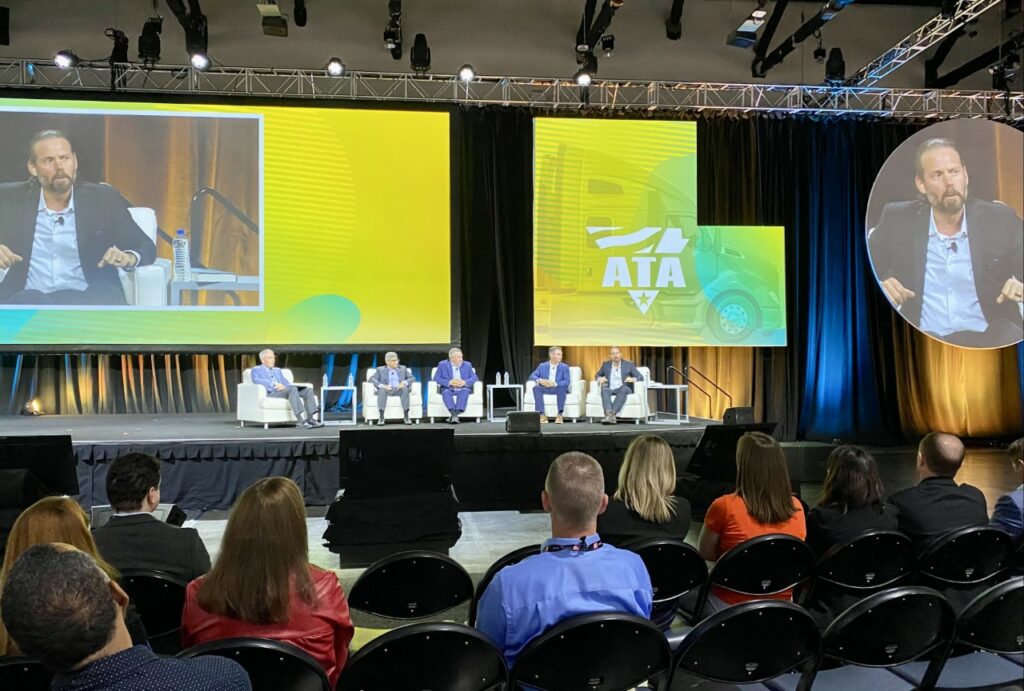Zero-emission targets remain a complex ‘Mars shot’
Michael Kiely, president – U.S. government affairs at UPS, dismisses the idea that sustainable trucking is anything new. The fleet has always strived to be as efficient as possible. But he worries that regulators now seem fixated on one or two ideas like battery-electric vehicles to eliminate emissions.
Some options still don’t fit into existing trucking operations — or aren’t available at all.
“We’ve been trying to buy a Tesla truck for six years now,” he said as an example, referring to the long-promised Tesla Semi battery-electric truck that Elon Musk says will deliver longer operating ranges.

While UPS is able to test emerging options, he also wonders what will happen to businesses with lesser resources. “I don’t see a smaller company able to survive some of those mandates,” he said, suggesting it’s irresponsible to force them to buy technologies that are not yet fully tested.
He wasn’t the only one to raise concerns during a panel discussion at the American Trucking Associations’ annual Management Conference & Exhibition.
‘Not yet ready’
“The technology is not yet ready,” said Knight Transportation senior vice-president – equipment and government relations David Williams. But deadlines set by California, and copied by many other states, are fast approaching. “We’re jumping from the bottom to the top without learning from the middle,” he added.
The unanswered questions include the limitations of individual platforms as well as the infrastructure to supply the all-important energy.
It can take 4.5 megawatts to set up the chargers for 30 trucks at one facility, Williams said as an example, noting this is enough energy to power a small city. But his fleet has just under 1,000 trucks at one location. When it asked a utility provider how chargers could be set up for such equipment volumes, the business was told it wasn’t possible.
As for the battery-electric trucks themselves, there are still challenges of added weights, purchase prices, and limited range.
A fuel-cell-electric truck can cost five times as much as diesel, and the fuel itself costs $10-$12 per diesel equivalent gallon, Williams said.
“I also think financial sustainability is important.”
Suites of technologies
Even where options can fit some operations, they fall short in other applications. It’s why the panelists stressed the need to consider a suite of technologies to meet emissions goals.
Cummins engine business president Srikanth Padmanabhan noted battery-electric vehicles offer an option for drayage and transit operations. But other options exist in renewable diesel, natural gas, and hydrogen. Even hybrid vehicles could apply battery-electric power in urban centers and switch to other alternatives on the open road.
“It’s not going to be one solution,” he said.
And it’s no simple solution, either. He refers to the work as a “Mars shot”.
Several gains could be realized by combining technologies, Kiely said, referring to a hybrid option with a diesel ignitor once offered by Cummins, generating a 20% boost in fuel efficiency. “The regulations got in the way but made it too expensive.”
It wasn’t the only shot at regulators during the session.
“We’ve got to have laws that make sense across the board,” Williams said, referring to diverging state and federal rules about allowable NOx levels. “You could take a load, and as you cross state lines, the rules change.”
A ‘myopic’ look at emissions
Nevada Trucking Association president Paul Enos even challenged the mindset behind zero-emission goals.
“’Net Zero’ only exists when you take a very myopic look at tailpipe emissions,” he said, noting how battery-electric technologies can’t match the energy density in diesel, and that related natural resources are difficult to reach.
“Even if we can move to all-electric, I’m not sure that we should — because the environmental challenges, the negative impacts you’re going to have on water supply, and land scarring, and mineral scarcity is tremendously more complex and worse for the planet,” he explained, referring to the rare earth metals needed for batteries.
One deposit in Maine is close to a ski resort, so he doubts that will ever be developed.
If politicians won’t consider these challenges, he wondered aloud if they will listen to city planners because of the fleet facilities that still can’t access the power required for charging. As for questions whether that’s really an issue: “Go and try to get an electric truck terminal permitted.”
“We need to get away from this catastrophizing and really take a more real-world view,” Enos said.
Panelists also raised concerns about proposed Securities and Exchange Commission (SEC) requirements to track Scope 1, 2 and 3 emissions. In other words, publicly traded companies would need to track emissions they’re directly responsible for, as well as the emissions generated by suppliers.
UPS has been disclosing carbon emissions for 20 years, but it is an expensive process, Kiely said, noting that it’s an inexact science.
The challenge isn’t limited to publicly traded carriers, either. “If you’re hauling for a public shipper, they’re going to be required to report their downstream emissions – which includes you,” Williams said.
Have your say
This is a moderated forum. Comments will no longer be published unless they are accompanied by a first and last name and a verifiable email address. (Today's Trucking will not publish or share the email address.) Profane language and content deemed to be libelous, racist, or threatening in nature will not be published under any circumstances.